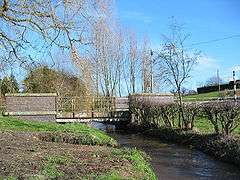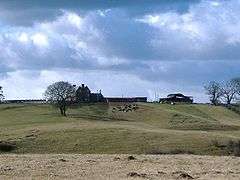Wych Brook
| Wych Brook | |
| River Elfe, Red Brook | |
| River | |
 The Wych Brook at Higher Wych | |
| Countries | Wales, England |
|---|---|
| Counties | Wrexham County Borough, Cheshire |
| Tributaries | |
| - left | Emral Brook |
| Source | |
| - location | Fenn's Moss, Wrexham County Borough |
| - coordinates | GB-WLS 52°56′8″N 2°43′35″W / 52.93556°N 2.72639°W |
| Mouth | River Dee |
| - location | near Shocklach |
| - coordinates | GB-WLS 53°2′19″N 2°51′42″W / 53.03861°N 2.86167°WCoordinates: GB-WLS 53°2′19″N 2°51′42″W / 53.03861°N 2.86167°W |
The Wych Brook or Red Brook, formerly known as the River Elfe, is a small river in the north-west midlands of the United Kingdom. It forms both the historic and present-day border between England (Cheshire) and Wales (Maelor Saesneg, a detached portion of Flintshire, now within Wrexham County Borough). It is a tributary of the River Dee.
Course and landscape
The Wych Brook rises (as the "Red Brook") at Fenn's Moss on the Wrexham / Shropshire border, and flows northward and westward through a steep-sided, wooded valley to Threapwood, being joined by several smaller streams such as the Grindley Brook, which rises near the village of the same name, and the Iscoyd Brook. Near the community of Willington Worthenbury it is joined by the Emral Brook, and runs northward to the Dee near Shocklach.[1] The Emral Brook itself rises near Penley and is joined by a number of tributary streams which drain the central part of Maelor Saesneg.
The middle section of the river valley, which has eroded deeply into an underlying glacial drift of boulder clay, sands and gravels, is the narrowest and deepest, particularly between Dymock's Mill and Lower Wych.[2] The river landscape is characterised by ancient mixed ash woodland, unintensively-farmed lowland pasture and rush pasture. The English side of the valley is designated as an Area of Special County Value.[3]

The Wych Brook was formerly known as the River Elfe or Elf. The origin of the name "Elfe" is in this case unknown, though the name "Wych" is thought to derive from saline springs in the area.
Ecology
The river is a habitat for a variety of fish including brown trout, common dace, the gudgeon gobio gobio, stone loach and common minnow. There is an unusual isolated population of dormice in the Wych Valley, as a result of an introduction of animals in 1996/7.[4]
References
- ↑ Maelor Saesneg, Clwyd-Powys Archaeological Trust
- ↑ The Wych Valley, Wrexham Borough Council
- ↑ The Wych Valley, WCBC
- ↑ Dormouse, Cheshire Region Biodiversity Partnership